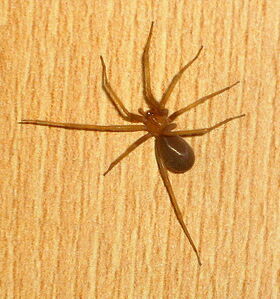
The Chilean recluse spider is a venomous spider, Loxosceles laeta, of the family Sicariidae (formerly of the
family Loxoscelidae). In Spanish, it (and other South American recluse spiders) is known as araña de rincón, or "corner spider"; in Portuguese, as aranha-marrom or "brown spider". This spider is considered by many to be the most dangerous of the recluse spiders, and its bite is known to frequently result in severe systemic reactions, including death.
Description[]
The Chilean recluse is one of the larger species of recluse spiders, generally ranging from 8–40 mm in size (including legs). Like most recluses, it is brown and usually has markings on the dorsal side of its thorax, with a black line coming from it that looks like a violin with the neck of the violin pointing to the rear of the spider resulting in the nickname "fiddleback spider" or "violin spider" in English-speaking areas. Coloring varies from light tan to brown and the violin marking may not be visible. Since the "violin pattern" is not diagnostic, it is far more important, for purposes of identification, to examine the eyes. Most spiders have eight eyes, but recluse spiders have six eyes arranged in pairs (dyads) with one median pair and two lateral pairs.
Like other recluse spiders, the Chilean recluse builds irregular webs that frequently include a shelter consisting of disorderly threads. Unlike most web weavers, they leave these webs at night to hunt. People get bitten when they unintentionally squeeze them in clothing and bedding. These spiders frequently build their webs in woodpiles and sheds, closets, garages, and other places that are dry and generally undisturbed. The spider frequently is found in human dwellings. The spiders can last a long time without food or water, a fact that encourages their worldwide spread.
Habitat[]
The Chilean recluse spider is native to South America. It is common in Chile, and can be found in Perú, Ecuador, Argentina, Uruguay, and south and eastern Brazil.
It has been introduced into North and several Central American countries, but does not naturally thrive in those locations. The spider is known to have established itself in the Los Angeles area. Infestations have been reported in Vancouver, British Columbia, Cambridge, Massachusetts, Florida, Finland, and Australia.
Medical significance[]
As indicated by its name, this spider is not aggressive and usually bites only when pressed against human skin, such as when putting on an article of clothing. Like all sicariid spiders, the venom of the Chilean recluse contains the dermonecrotic agent, Sphingomyelinase D, which is otherwise found only in a few pathogenic bacteria. According to one study, the venom of the Chilean recluse along with the six-eyed sand spider, contains an order of magnitude more of this substance than that of other sicariid spiders such as the brown recluse. For a comparison of the toxicity of several kinds of spider bites, see the list of spiders having medically significant venom.
Spectrum of disease[]
Disease may range from a minor bite with mild skin irritation, to severe skin necrosis, called cutaneous loxoscelism, to a less common syndrome in 10-15% of cases, a systemic illness called viscerocutaneous loxoscelism, because it involves inner organs. Cutaneous loxoscelism results from serious bites causing a necrotising skin ulcer with destruction of soft tissue and may take months, and rarely years to heal, leaving deep scars. The damaged tissue will become gangrenous black and eventually slough away. Initially there may be no pain from a bite, but over time the wound may grow to as large as 10 inches (25 cm) in extreme cases. Bites are felt initially but may take up to seven hours to cause visible damage; more serious systemic effects may occur before this time, as venom of any kind spreads throughout the body in minutes. Viscerocutaneous loxoscelism manifests with skin blanching due to vasoconstriction, sometimes a dengue-like scarlatiniform rash, hemolysis, sometimes resulting in hemoglobinuria and renal failure, and death in 3%–4% of cases per a clinical study in Chile.
Treatment[]
Application of an ice pack helps as first aid, because the venom is more active at high temperatures. Applying aloe vera may soothe and help control the pain. The spider should be brought with the patient in a clear, tightly closed container for identification, if it can be captured. However, by the time the bite is noticed any spider found nearby is not likely to be the culprit.
Prompt medical care should be sought. It usually takes several hours for the onset of severe pain as the venom spreads.
Polyclonal equine intravenous antivenom is produced in Brazil, and no commercial product is available in North America. Animal models have shown it to be effective only when given within the first 12 to 24 hours after a bite. No prospective controlled human clinical trials exist. Retrospective data are limited because they lack a definition of time to antivenom administration and its relation to outcome.
In South America, dapsone has been tried at 100 mg/day for one week, unless there is active hemolysis or G6PD deficiency. No controlled trials have been reported; the practice is controversial, but clinical experience in Perú and several limited studies support this practice. Systemic corticosteroids are often considered, but without clinical trials to support the practice.